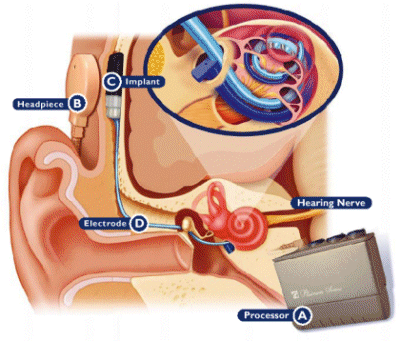Hearing aids amplify sound and rely on the integrity of the hair cells of the inner ear. Patients with severe to profound hearing loss may, therefore, obtain limited or no benefit for speech perception. A cochlear implant, on the other hand bypasses/replaces damaged hair cells and directly stimulates the auditory nerve. The electrodes in the internal component of the implant provide the "electrical spark" that is picked up by the nerve and taken to the brain for interpretation. Because these electrodes lie along the length of the cochlea, it is possible to have access to the full range of sounds even where there were no hair cells present.
It is important to note that the insertion of the electrode array results in total hair cells loss; consequently, a hearing aid cannot be used in the implanted ear.
How the Implant Works
Currently, three different cochlear implants are approved for clinical use in Canada. Each implant system consists of two parts: an internal component and an external component.
Internal Component

Photo courtesy of The Advanced Bionics Corporation.
The internal component consists of a decoder and magnet housed in protective casing. The electrode array
extends from this casing. The surgeon will drill into the skull to make a "bed" for the decoder. The remainder of the internal component sits on the skull but under the skin. The magnet picks up the information provided from the external components. The internal component then determines which electrodes will fire with what power/current.
External Components
The external components consist of a microphone, a series of cords, a transmitting coil and a speech processor. Each part must be worn in order for the device to work. The microphone picks up sounds preferentially from the front of the listener and transmits the sound along the long cord to the speech processor. The speech processor contains a program individual to each listener indicating the minimum amount of current needed for a sensation of first hearing and the maximum amount of current tolerable. This program extracts the most important aspects of the incoming speech signal and transmits this information back up the long cord across to the transmitting coil. The signal travels across the skin via radio frequencies to the internal component. As mentioned earlier, the decoder of the internal component takes this information and determines which electrodes will fire and with what power. This processing of sound takes place in real time, not like a foreign film where the voices and lip movements are not in synchrony.


